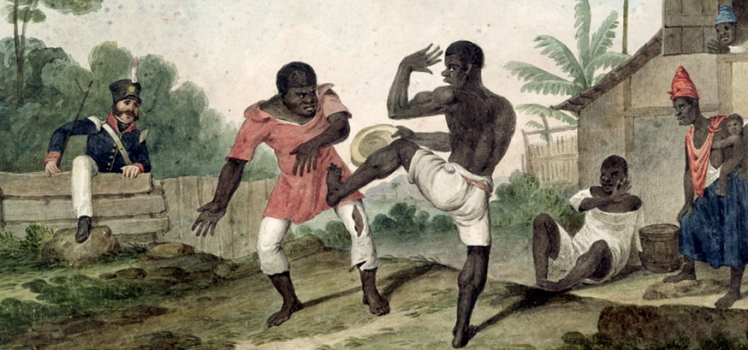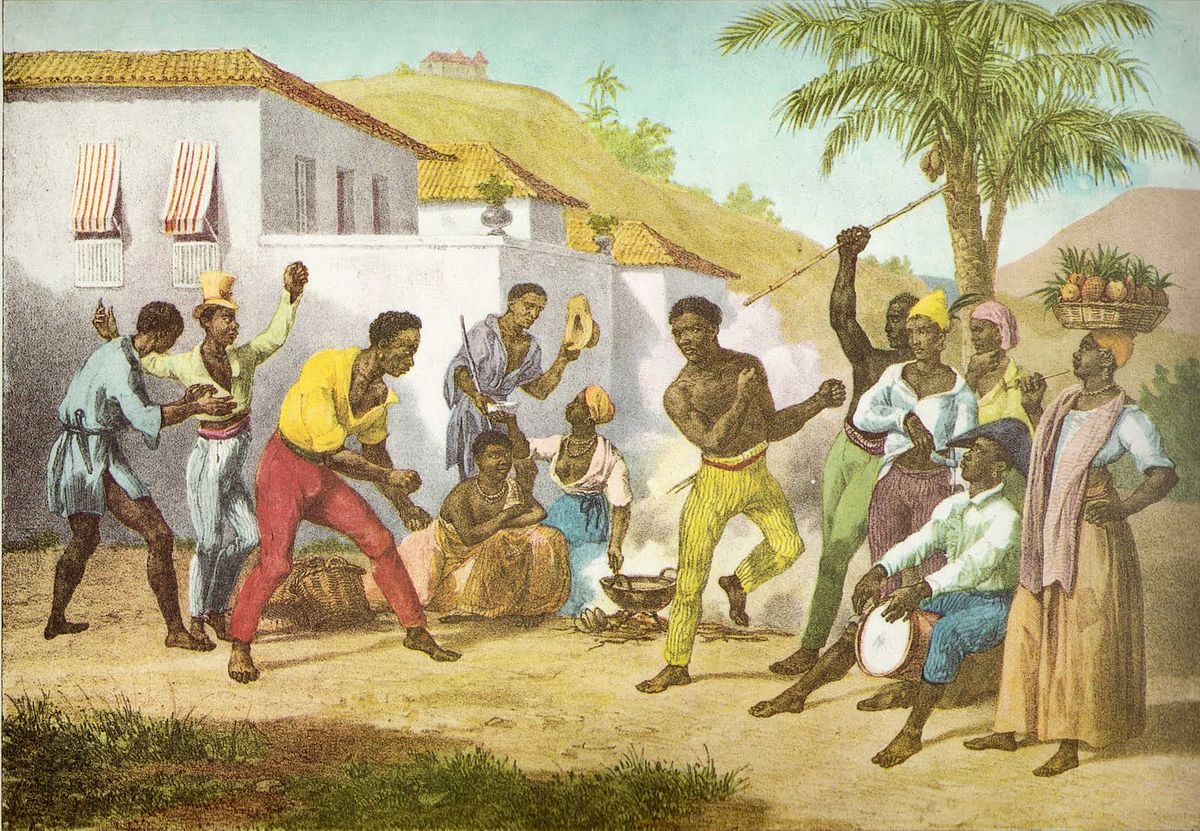We use cookies to ensure that we give you the best experience on our website. Check more information here. If you continue to use this site we will assume that you are happy with it. OK

In 1500 under the leadership of the Conqueror Pedro Alvarez Cabral the Portuguese came to Brazil. Their main aim was to subject the local population (Brazilian Indians) and provide themselves with labor force to implement their projects here. Thus, the slaveholding period had begun in Brazil like in USA. Brazilian Indians who were local inhabitants had died or escaped to impenetrable jungle due to heavy and unbearable labour regime for a long time. There was necessity to bring slaves from the other colonies due to the lack of strong labour force in sugar and tobacco plantations. Undergoing failure, the Portuguese began to bring free men and women by force to Brazil from the Africa colonies, namely, Angola, Congo, Mozambique, Guinea, etc. to work in plantations. Thus, as a result of migration of slaves to the West caused the development of popular beliefs, cultures and traditions. Two million slaves were brought from Africa to Brazil in slave trade history. Generally, slaves were distributed among three ports of Brazil, i.e. Bahia, Recife and Rio-de-Janeiro. In Rio and Recife the difference in the ethnic origin, sometimes their descent from hostile tribes impeded their uprising. Many slaves in Rio were Bantu peoples and those in Bahia descended from the West Africa. In general, the African slaves brought to Brazil can be divided into three major groups. They include: Sudan group generally consisting of Yoruba Dahomean nations; Guinea Sudan groups consisting of Muslims from Malesia and Hausa, and Bantu groups of Angola, Congo and Mozambique nations (there were Congolese, Chimbonda and Kasanjelly among them, too). The disputes on whether Capoeira originated from Africa or Brazil are still in progress.
Despite historical investigations are abundant with different facts, there is no certain fact confirming the idea of where and who established Capoeira. However, various versions exist about the way of origin of Capoeira. These are as follows: One of the most popular versions is the idea that "Capoeira is art of fighting assimilated with dance to be performed before the entrepreneurs". But this version also causes doubts, as in 1814 - the period when African culture was persecuted, Capoeira like other kinds of African dances was prohibited. That is why it was useless to assimilate Capoeira with dance. According to another popular version, young fighters of the tribe were performing knight dance during the ceremony of Mukupe people living in the south of Angola. This dance called "N'golo", the dance of zebra. This dance is considered to be the origin of Capoeira. No verisimilar evidence and facts are available to confirm this version.
The most popular version is connected with Quilombo dos Palmares. When slaves understood that their situation is unbearable and they are considered to be labor force forever, they started to run away. In Recife for the first time the group of 40 slaves revolted against their owner killed all the white workers and burnt out the plantations. Purposed to be free they started to look for a place to hide from slave hunters. As a result of the assistance of the local Hindus, they found a safe place. They called this place being full of palms Palmares. Here was established African community and this community has lived here for about a century. The development of the primary forms of Capoeira started in this community. Here also lived white men and Hindu along with the Africans. Palmares with its population over 20 thousands men constituted a menace for colonialists.

In 1630 the Dutch occupied Brazil after defeating the Portuguese. The Dutch failed to carry out several consequent military operations they prepared for Palmares. In reply to these operations by setting traps in the jungles the Africans managed to give a blow to the Dutch several times applying Capoeira attack elements. During this period of time Capoeira had already become a weapon.
The slaves who called Capoeira a symbol of freedom, added music, singing, dancing and other rituals to Capoeira to conceal their mastering this lethal art of fight. The main reason for Palmares version to conform to Capoeira origin history was that other popular versions originated in this history. Capoeira passed a difficult way of development. The historical process of its development can be divided into two ages: Slavery and Idling. The age of Slavery is characterized by toil, generalization of interests for providing living and combination of people's believes, cultures and traditions. With the lapse of time new cultural views began forming. A game built of the combination of dance-fight, rhythm, African music and kicks taken from the separate kinds of sport made Capoeira keep abreast with the time. In 1888 the "Gold law" was signed and the slavery was abolished.
A new age of Capoeira development began. In the age of Idling Capoeira became widespread in the streets and the street robbers mastered it and started to develop it further. That is why in 1892 Capoeira was banned by the "First Constitution of the Republic of Brazil". At the beginning of the 19th century it was decreed to form special police groups to struggle with Capoeira dancers. The tradition was established and keeps staying till present among Capoeira dancers of that time to give nicknames to each other. Despite all this, in 1928 owing to Master Bimba's efforts it was permitted to perform Capoeira and develop it. Manuel dos Reis Machado is known in the history of Capoeira as the founder of Regional style and Master Bimba. He was born in Salvador (Brazil) in November 23, 1900 and began learning Capoeira since 12. From year to year he larded the block of Capoeira motions with the elements from the other African art of fighting named "Batuki". After Master Bimba made an original presentation of unprecedented values of the art and culture of Capoeira before the governmental palace of Bahia State in 1928, Capoeira was highly assessed by the government representatives and for the first time an official permission was given to go in for Capoeira in the areas under special supervision of the police. Founding the first school (academy) of Capoeira in Salvador in 1932, Master Bimba again made supplements (the system of white uniform and a belt) to Capoeira rules. But this school was made official only after Master Bimba got an official invitation from Getúlio Vargas, the President of Brazil to perform Capoeira and was certified by the Ministry of Education of Brazil as a result. In 1942 Master Bimba founded the second school of Capoeira. This school keeps operating till nowadays. Master Bimba devoted his life to the development of Capoeira and even in the day of his death (February 5, 1974) prepared Capoeira performance.
One of the legendary persons in the history of Capoeira was Vicente Ferreira Pastinha, the founder of "Angola" style of Capoeira and known as Master Pastinha. He was born in Salvador in April 5, 1889. When a child, he got acquainted with Capoeira from an African sailor. Though he entered Marine school in youth, he quitted his job of a sailor and started teaching Capoeira. As he was the author of a number of aphorisms, he was named "the Philosopher of Capoeira". In 1941 he got an invitation from his pupil to street hoda "Ladeira do Gengibirra" (Salvador). The participants ask the master to teach them. Thus, Angola Capoeira Sport School was founded. The uniform of the school was "black and yellow", because the uniform of Master's favorite football team was the same color. The activity of the academy is weakened as a result of different pressures by the Government. Master Pastinha, who lived in the little room, blind and very sorrowful in his final years died in 1982 at the age of 92. After his death, his apprentices Master Joao Grande and Master Joao Pequeno continued the trainings of Angola style. Capoeira was increased rapidly during 50 years of the last year, new academies and international groups were established, different competitions and ceremonies were hold. So, Capoeira was accepted as the national sport of Brazil in 1974.
Now Capoeira schools, academies, national federations and international groups act not only in Brazil, but also in all points of the world. ABADA, Muzenza, Axe, Senzala, Cordao de Ouro, Capoeira Brazil acts more widely.
"ABADA-Capoeira" - the Brazilian Association for the Support and Development of the Art of Capoeira. Master Camisa, the famous apprentice of Master Bimba, who choose a device to protect traditions and at the same time to conform to the requests of new period the history of Capoeira established this group in 1988. More of 50.000 members from more of 20 countries were included in the composition of this group.
"Muzenza" - was established in 1972 by Master Paulao, who was the apprentice of Master Mintirinha, the head of Obaluae group. The full leadership of group charged with Master Burgues in 1975. Every year the group holds the world and European championship.
The aim of "Axe Capoeira" - Master Barrão was to develop all aspects of Capoeira, he established "Axe Capoeira" international group in 1982 and registered it officially with the help of Master Piraja in 1987. Now the Capoeira schools acts in more than 20 countries of the world under the name of "Axe Capoeira" organization.
"Senzala" was established by Flores brothers, Paulo, Rafael and Gilberto in 1960. Each of Flores brothers was the apprentices of Master Bimba and Master Pastinha. Now Senzala schools act in USA, Portuguese, France, Germany, Italy, Holland, Denmark, Serbia, Finland and Ukraine.
"Cordao de Ouro" means Gold Belt. It was founded by Master Suasuna and Master Brazil in 1967. It differs from all Capoeira schools for its peculiar technique and the schools of this organization act in more than 20 countries of the world.
GCB. The root of "Capoeira Brazil" originated from the group of "Senzala". It was established by Master Poulinho Sabiá, Master Boneco and Master Paulão Ceara in Rio de Janeiro in 1989. The academies of the organization act in 15 states of USA, Holland, France, Japan, Turkey and Australia.
Except the above mentioned international Capoeira groups, several other international groups and schools act in the world..